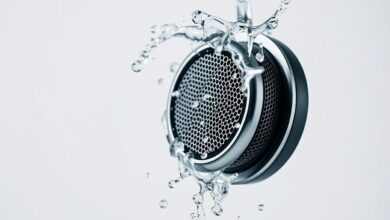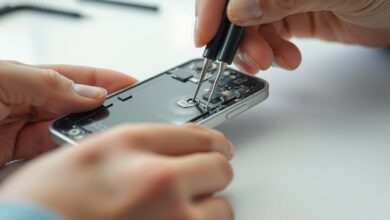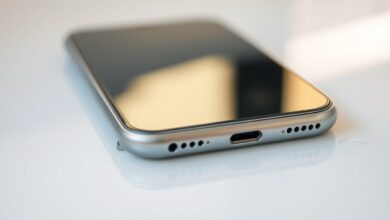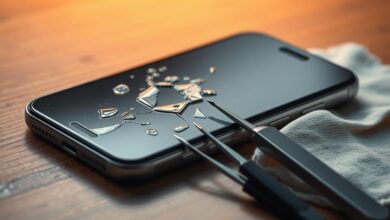how to remove water from charging port
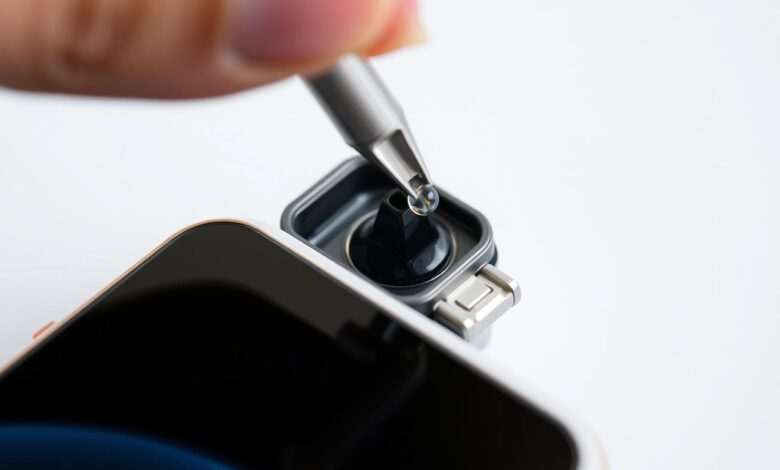
Water in your device’s charging port can cause big problems. If not fixed quickly, it can damage your device’s inside parts. This can make your device stop working.
I’ll show you how to safely get water out of your device’s charging port. We’ll cover the first steps, drying methods, and how to prevent water damage in the future.
By taking these steps, you can protect your device from harm. This way, it should work like new again.
Key Takeaways
- Immediate action is necessary when water enters the charging port.
- Turning off the device is the first step to prevent short circuits.
- Using desiccants or silica gel packets can help dry out the port.
- Avoid using heat to dry the charging port.
- Inspect the port for debris before attempting to charge the device again.
Understanding the Risks of Water in Your Charging Port
Water in your charging port is a big problem that needs quick action. It can harm your device’s inside parts a lot.
Water in the charging port can cause many problems. It can make your device stop working right away. Or, it can damage it for a long time if not fixed right. For tips on fixing a wet phone, check out wikiHow.
How Water Damages Electronic Components
Water harms electronic parts in a few ways. First, water can make short circuits in your device. Second, it can rust metal parts, making things worse.
Rust takes time but keeps going, making parts fail slowly. Knowing this helps you act fast when water gets into your device’s charging port.
Common Scenarios Leading to Water Exposure
There are a few common times when water might get into your charging port. These include dropping your phone in water, getting caught in the rain, or being in very humid places.
| Scenario | Likelihood of Damage | Recommended Action |
|---|---|---|
| Accidental Drop into Water | High | Immediate drying required |
| Exposure to Rain | Moderate | Dry the device as soon as possible |
| High Humidity Environment | Low to Moderate | Monitor device condition closely |
Knowing these risks and situations helps you protect your device. It lets you take steps to avoid water damage to your charging port.
Immediate Actions to Take When Water Enters Your Charging Port
When water gets into your device’s charging port, you must act fast. Water and electronics can be a bad mix. It can cause short circuits, corrosion, and harm your device.
Power Off Your Device Immediately
The first thing to do is to power off your device right away. This step stops short circuits that could damage your device more. Turning off your device keeps electrical parts away from water.
Remove External Connections
Then, take off any external connections from your device. This means chargers, headphones, and cables. Removing these stops water from getting trapped and lowers damage risks.
Position Your Device to Drain Water
After that, place your device to let water drain. Gently tilt your device to let water flow out of the charging port. Don’t shake or jolt your device, as it could push water into the inside parts.
By doing these steps quickly, you can lessen damage to your device’s charging port and inside parts. Good charging port moisture removal and drying charging port methods are key to saving your device.
How to Remove Water from Charging Port: Step-by-Step Guide
Drying your charging port after water damage needs patience and the right steps. First, check the damage and use safe drying methods. Then, let it dry naturally.
Initial Assessment of Water Damage
Start by checking how much water got in. Look for signs of water inside your device. Shake it gently to see if you hear water moving.
Safe Manual Drying Techniques
To dry it manually, tilt your device to let gravity help. Use a soft, dry cloth to pat the outside. Avoid using sharp objects or cotton swabs to prevent damage.
For better drying, use compressed air made for electronics. Spray it into the port in short bursts. But, don’t spray too closely or with too much force.
Allowing Natural Evaporation
After manual drying, let it dry naturally. Put your device in a dry, well-ventilated area. Let it sit for at least 24 to 48 hours to let moisture evaporate.
By following these steps, you can remove water from your charging port. This helps prevent long-term damage to your device.
Using Compressed Air to Dry Your Charging Port
Compressed air is a useful tool for drying your device’s charging port. But, it must be used carefully. Water in the port can harm your device if not fixed quickly.
Proper Technique for Using Compressed Air
First, make sure your device is turned off. Hold the can upright and spray air in short bursts into the port. Move the can to cover all parts of the port.
- Hold the can upright to prevent liquid from entering the port.
- Use short bursts to avoid pushing water further into the device.
- Move the can around to cover all areas of the port.
Recommended Pressure Settings
The pressure setting is key when using compressed air. Look for the recommended pressure on the can’s label. It’s best to use the lowest pressure to protect your device’s parts.
Key considerations:
- Check the can’s recommended pressure setting.
- Start with the lowest pressure and increase as needed.
Precautions When Using Compressed Air
Compressed air is effective but requires caution. Don’t spray too close or directly into the port to avoid damage. Also, be careful not to push water deeper into your device.
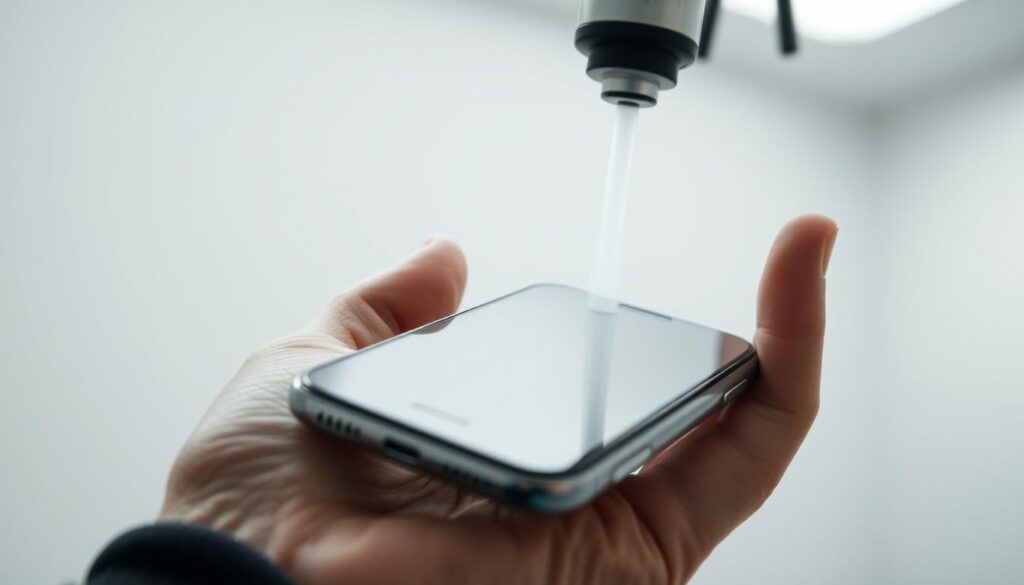
The Rice Method: Does It Really Work?
Using rice to dry a wet charging port is a topic of debate. Many claim it works, saying rice absorbs moisture. But, the science behind it is not straightforward.
Scientific Explanation of the Rice Method
The rice method relies on rice acting as a desiccant. But, ordinary rice is not very effective at controlling humidity. Studies show rice is not as good at drying wet electronics as other desiccants.
Rice doesn’t absorb moisture quickly or efficiently. This makes it hard to save water-damaged devices.
Better Alternatives to Rice
Given rice’s limitations, it’s smart to look at other methods for charging port moisture removal. Silica gel packets, for example, are better desiccants than rice. They absorb moisture more efficiently.
Other options include using a dehumidifier or specialized drying equipment for electronics. These alternatives might be more reliable for drying a wet charging port.
Using Silica Gel and Desiccants for Water Removal
Silica gel and desiccants are great for drying out your charging port after water damage. They soak up moisture, making them perfect for small spaces like charging ports.
How Desiccants Work
Desiccants, like silica gel, pull moisture from the air. They have tiny pores that grab and hold water molecules. This reduces humidity around your device’s charging port, helping to dry it safely.
Desiccants are effective because they can absorb a lot of moisture at room temperature. They’re a gentle and safe way to dry electronic parts, unlike heat-based methods.
Proper Application Methods
To use desiccants, put your device in a container with silica gel packets or other desiccants. Seal the container to keep it dry. Leave your device there for a few hours to overnight.
Make sure desiccants don’t touch your device’s internal parts to avoid damage. Use a cloth or bag to keep them separate.
Where to Purchase Effective Desiccants
You can find good desiccants in stores and online. Hardware stores, electronics stores, and Amazon often have them. Look for products made for moisture absorption and read reviews.
You can also use desiccants from items like shoe boxes or with electronics. Just make sure they’re clean and dry before you use them.
Utilizing Heat Methods Safely
Using heat to dry a wet charging port is common, but it must be done carefully. Water in your device’s charging port can be hard to remove without causing more damage. Heat can help, but it’s important to avoid harming your device’s parts.
Using a Hairdryer Correctly
A hairdryer is a good tool for drying a wet charging port. Make sure to use the low or cool setting. High heat can damage your device’s parts, so it’s best to avoid it.
Keep the hairdryer at least 6 inches away from your device. This helps spread the heat evenly and prevents overheating. Move the hairdryer slowly to dry everything evenly. This method can help with charging port cleaning and fixing water damaged charging port issues.
Be patient and don’t rush the drying process. It might take some time to dry your charging port completely. Avoid overheating any area to prevent damage.
Other Safe Heat Sources
There are other safe heat sources besides a hairdryer. Some devices have special drying settings or tools. You can also use a warm oven or a desiccant with gentle heat, but be careful.
Always watch your device for signs of overheating or damage. If you see smoke, unusual smells, or malfunctioning, stop using heat right away.
Professional Tools for Charging Port Water Removal
When your device’s charging port gets water damage, using professional tools is best. Water damage can be tough, needing more than simple DIY fixes.
Specialized drying equipment is made for fixing water damage in devices, like charging ports. These tools dry out parts safely, avoiding damage from wrong DIY methods.
Specialized Drying Equipment
Many tools help dry out water-damaged charging ports. The vacuum desiccation device uses a vacuum to dry. The ultrasonic cleaning device gently removes corrosion and debris.
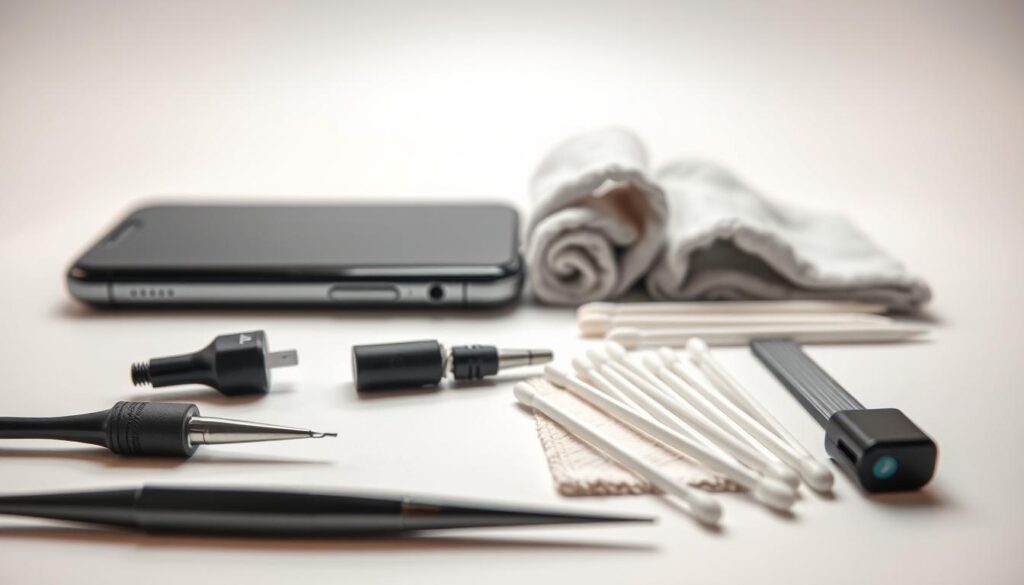
Where to Find Professional Tools
You can find professional tools for charging port water removal from different places. Electronic repair shops often have these tools and can fix water damage. Online sites like Amazon or eBay also sell them, but buy from trusted sellers.
A pro says, “The right tools for water damage repair can greatly improve fixing a device.” This shows why using professional-grade equipment is key.
“The key to successful water damage repair is not just about drying the device, but doing so in a way that prevents further damage to its delicate components.”
If your device’s charging port has water damage, looking into professional tools and services is a good idea.
Device-Specific Considerations
When trying to get water out of charging ports, it’s key to think about the device. Each one is different, needing its own way to dry out.
iPhone Charging Port Water Removal
iPhone users should be careful when trying to dry their charging port. The Lightning port’s small size makes it hard to dry.
Lightning Port Specifics
The Lightning port is tiny and has complex parts. A soft brush or cotton swab can help get rid of water.
iPhone Water Detection Systems
iPhones have systems that warn of water damage. If your iPhone says it’s wet, act fast to avoid harm.
Android and USB-C Port Water Removal
Androids with USB-C ports need special drying methods. Compressed air or a desiccant can help dry them out.
Water-Resistant Devices: Special Considerations
Even water-resistant devices can get damaged by water. If water gets in, follow the maker’s drying and check-up tips. As Apple says, “Liquid damage isn’t covered under warranty for most Apple products,” so act quickly.
The Android Authority advises using a port cleaning tool or small brush for USB-C ports. This shows the need for the right tools.
In summary, drying a charging port needs a specific plan for your device. Knowing your device’s unique features helps dry it out and avoid damage.
Testing Your Charging Port After Water Removal
After removing water from your charging port, it’s important to test it. This ensures it works right and avoids more damage to your device.
To test your charging port safely, follow certain steps. For more detailed instructions, check out guides on how to get water out of your charging port.
Safe Testing Methods
First, look at the port for any leftover moisture or dirt. Use a flashlight and a magnifying glass if needed. Then, try charging your device with a charger you know works. If it charges okay, that’s a good sign.
You can also test with different cables or chargers. This helps figure out if the problem is with your accessories.
| Testing Method | Description | Expected Outcome |
|---|---|---|
| Visual Inspection | Check for moisture or debris | No visible water or debris |
| Charging Test | Use a known working charger | Device charges normally |
| Cable/Charger Variation | Try different cables or chargers | Device charges with different accessories |
Signs That Water Is Still Present
If water is still in your charging port, you might see some signs. Look for corrosion on metal parts, odd charging behavior, or if your device won’t charge. These signs mean water is still a problem.
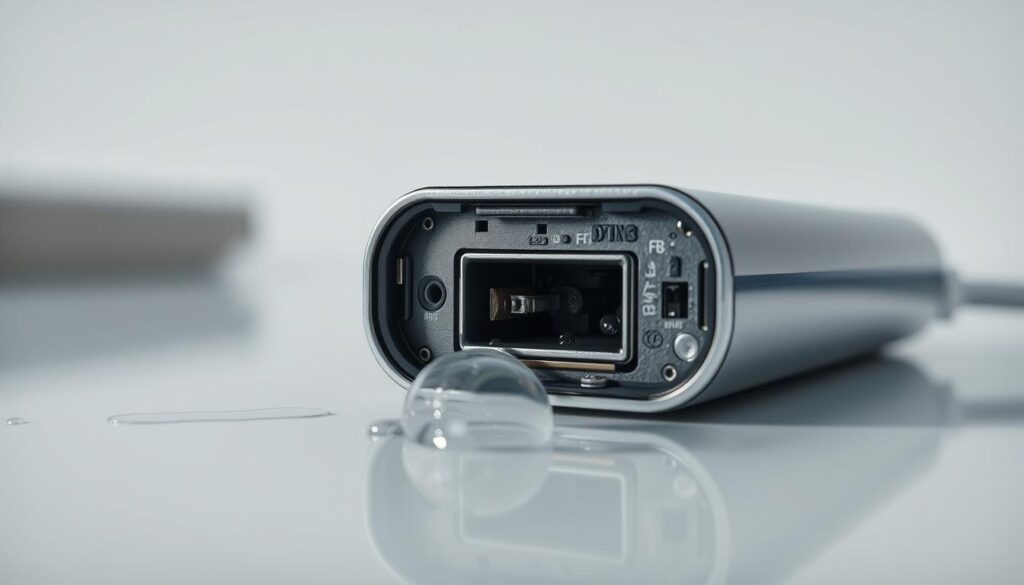
Corrosion is a big problem that can really harm your device. If you think there’s corrosion, get help from a pro. To dry the port, using silica gel packets or desiccants can help.
What Not to Do When Removing Water from Charging Port
It’s crucial to know what not to do when your charging port gets wet. The actions you take right after can greatly affect your device’s life and function.
Dangerous Methods to Avoid
Some methods to dry your charging port can actually harm it. Avoid using sharp objects to clean or dry the port, as they can damage the internal components. Also, blowing into the port can push moisture further inside and introduce bacteria or other contaminants.
Using a vacuum cleaner to dry the charging port is another method to avoid. The suction power can be too intense, potentially damaging the port’s internal structures or dislodging critical components.
- Refrain from using unproven or homemade methods that claim to dry out the charging port.
- Avoid exposing your device to extreme temperatures, as this can cause additional damage to the electronics.
Common Mistakes That Cause Further Damage
One of the most common mistakes is inserting foreign objects like cotton swabs or paper towels into the charging port. These can leave behind fibers or cause physical damage to the port.
Another mistake is not turning off the device immediately after water exposure. Continuing to use or failing to power off your device can lead to short circuits, causing irreversible damage.
By understanding what not to do, you can significantly reduce the risk of further damage to your device’s charging port. This knowledge, combined with the appropriate drying techniques, can help ensure your device is restored to working condition.
When to Seek Professional Help
If you’re not sure about the water damage or if your device still doesn’t work, get professional help. Even if you try to remove water from your charging port, some damage might be too much for you to handle alone.
Signs of Serious Water Damage
Signs of serious water damage include corrosion. This can really harm your device’s inside parts. Look out for corrosion, device problems, or if it won’t turn on. If you see these signs, it’s time to get help from a pro.
Finding Qualified Repair Services
To find a good repair service, start by checking online reviews and ratings. Look for services that focus on water damage repair and know your device type. Also, consider manufacturer-authorized service centers. They have the right skills and parts.
Expected Costs for Professional Repair
The cost for professional repair can vary a lot. It depends on the damage and your device type. You might pay $50 to $200 or more for charging port fixes. Always ask for a quote before starting the charging port water removal process.
Conclusion
Removing water from a charging port is urgent and needs careful steps to avoid damage. We’ve looked at many ways to do this, like quick actions, drying guides, and using tools like compressed air and silica gel.
It’s important to know the dangers of water in charging ports. Even if your device is water-resistant, water can still get in. By following the right steps and knowing what to avoid, you can protect your device.
In short, being ready and acting fast when water gets into your charging port can save your device. This advice works for phones and other gadgets. By following these tips, you can keep your device working well.
FAQ
How do I know if my charging port has water damage?
If your device won’t charge, or you see corrosion in the port, it might be water damaged. Check the port and try different chargers to see if it’s just a problem with your current one.
Can I use a hairdryer to dry my charging port?
You can dry a charging port with a hairdryer, but be careful. Use low heat and keep it away to avoid damage. Don’t push water into the port.
Is the rice method effective for drying a wet charging port?
Rice can help dry a port, but it’s not the best method. Silica gel or desiccants work better. If you use rice, seal your device in a container with it.
How can I prevent water from entering my charging port in the future?
To keep water out, use a waterproof case. Avoid water and moisture, and be careful when charging near water.
What are the signs that I need to seek professional help for water damage?
If your port has corrosion or your device still won’t work after drying, get help. Visible damage or uncertainty about repairs also mean it’s time to seek professional help.
Can water damage to my charging port be repaired?
Yes, many water damages can be fixed. The damage’s extent will decide if you can do it yourself or need a pro. Severe damage might mean it’s cheaper to replace your device.
How long does it take to dry out a charging port?
Drying time varies with water amount and method. It can take hours to days for the port to dry completely.
Are there any professional tools available for charging port water removal?
Yes, pros use specialized tools for repairs. You can find these through repair suppliers or online.
Is it safe to use compressed air to dry my charging port?
Compressed air can work, but use it carefully. Follow the manufacturer’s guidelines to avoid pushing debris or causing damage.
What are the best practices for maintaining a healthy charging port?
Keep your port dry and clean. Use a soft brush or cotton swab when needed. Avoid damaged or old charging cables.
